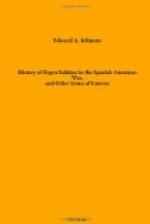In an interview with a World correspondent at that time he expressed himself as grateful to Americans.
In July he issued a proclamation fixing the 12th day of that month for the declaration of the independence of the Philippines.
In November Aguinaldo defied General Otis, refusing to release his Spanish prisoners.
The Cabinet on December 2 cabled General Otis to demand the release of the prisoners.
[Illustration: EMILIO AGUINALDO, MILITARY DICTATOR OF THE FILIPINOS.]
AGUINALDO THE MAN.
In his features, face and skull Aguinaldo looks more like a European than a Malay.
He is what would be called a handsome man, and might be compared with many young men in the province of Andalusia, Spain. If there be truth in phrenology he is a man above the common. Friends and enemies agree that he is intelligent, ambitious, far-sighted, brave, self-controlled, honest, moral, vindictive, and at times cruel. He possesses the quality which friends call wisdom and enemies call craft. According to those who like him he is courteous, polished, thoughtful and dignified; according to those who dislike him he is insincere, pretentious, vain and arrogant. Both admit him to be genial, generous, self-sacrificing, popular and capable in the administration of affairs. If the opinion of his foes be accepted he is one of the greatest Malays on the page of history. If the opinion of his friends be taken as the criterion he is one of the great men of history irrespective of race.—The Review of Reviews.
FACTS FROM FELIPE AGONCILLO’S LETTER IN LESLIE’S MAGAZINE.
Sixty per cent, of the inhabitants can read and write.
The women in education are on a plane with the men.
Each town of 5,000 inhabitants has two schools for children of both sexes. The towns of 10,000 inhabitants have three schools. There are technical training schools in Manila, Iloilo, and Bacoler. “In these schools are taught cabinet work, silversmithing, lock-smithing, lithography, carpentering, machinery, decorating, sculpture, political economy, commercial law, book-keeping, and commercial correspondence, French and English; and there is one superior college for painting, sculpture and engraving. There is also a college of commercial exports in Manila, and a nautical school, as well as a superior school of agriculture. Ten model farms and a meteorological observatory are conducted in other provinces, together with a service of geological studies, a botanical garden and a museum, a laboratory and military academy and a school of telegraphy.”
Manila has a girl’s school (La Ascuncion) of elementary and superior branches, directed by French, English and Spanish mothers, which teaches French, English literature, arithmetic, algebra, trigonometry, topography, physics, geology, universal history, geography, designing, music, dress-making and needle-work. The capital has besides a municipal school of primary instruction and the following colleges: Santa Ysabel, Santa Catolina, La Concordia, Santa Rosa de la Looban, a hospital of San Jose, and an Asylum of St. Vincent de Paul, all of which are places of instruction for children. There are other elementary schools in the State of Camannis, in Pasig, in Vigan and Jaro.




